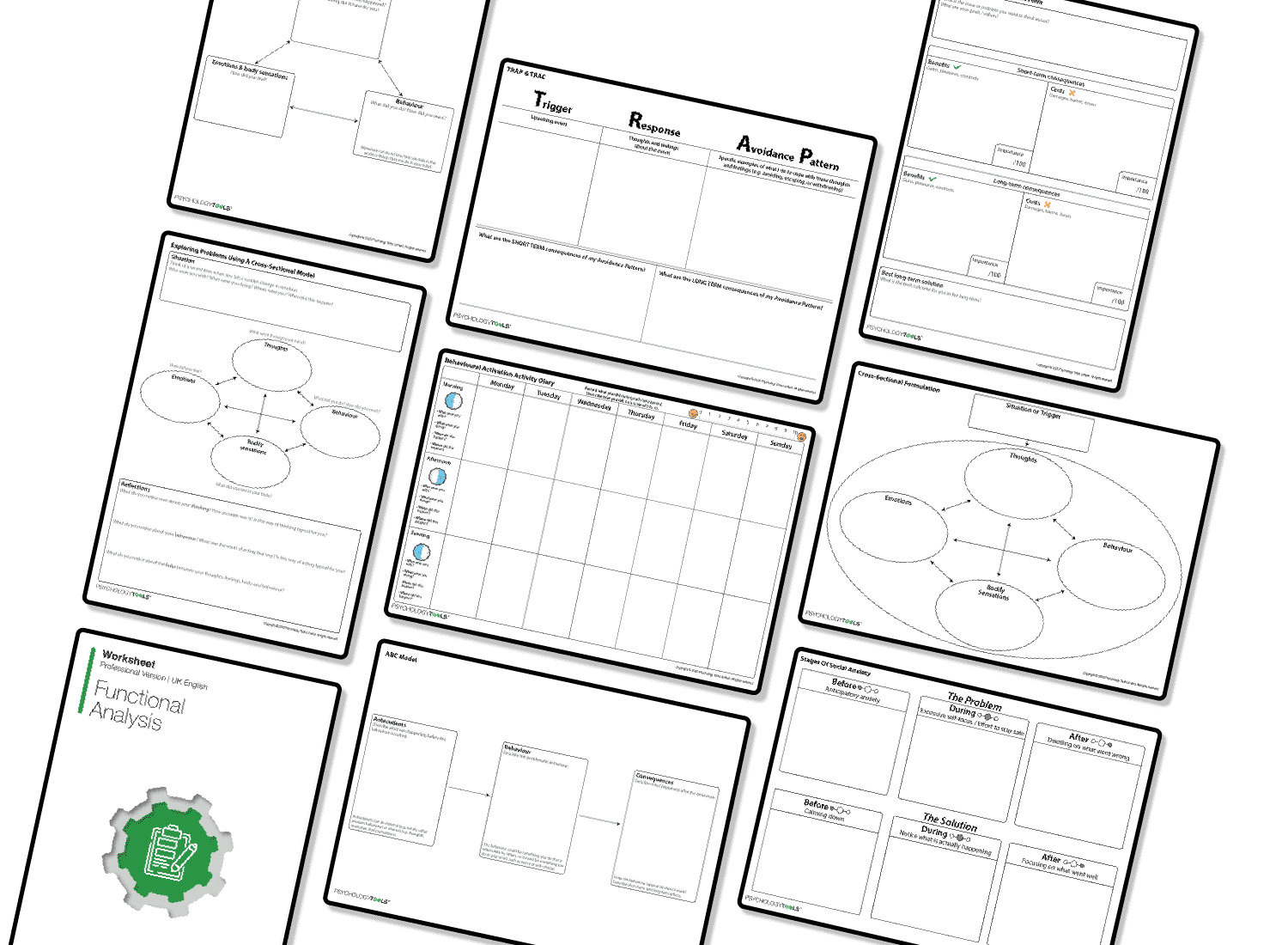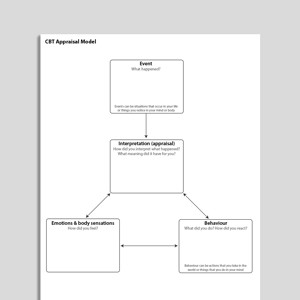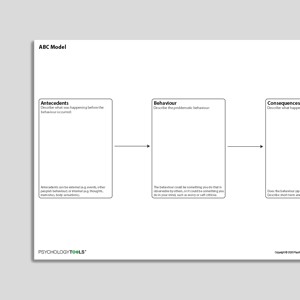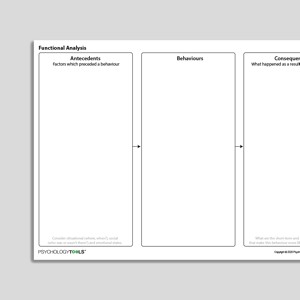
Functional analysis examines the causes and consequences of behavior. It is underpinned by the principles of behaviorism and behavioral analysis (Carr & LeBlanc, 2003; Rummel, Garrison-Diehn, Catlin, & Fisher, 2012). It seeks to understand a specific target behavior (or problem behavior) and identify the triggers and reinforcers that cause and maintain the behavior (Iwata et al, 1994; Yoman, 2008). Functional Analysis can be applied across a wide range of settings and conditions, since it focuses on the individual and the immediate context of their behavior, rather than their diagnosis (Haynes & Hayes O’Brien, 1990). Within cognitive behavioral therapy, functional analysis can be used to help clients understand their own behavior, and it can be applied more directly as a method of assessment, formulation and treatment. Read more
See recommended resources Recent releases

Case conceptualizations (formulations) help therapists and clients come to a shared understanding of a problem. This Cross Sectional Formulation explo . https://www.psychologytools.com/resource/cross-sectional-formulation

Behavioral activation (BA) is an effective treatment for depression. Different behavioral activation protocols include a variety of treatment componen . https://www.psychologytools.com/resource/behavioral-activation-activity-diary

The CBT Appraisal Model worksheet is a transdiagnostic formulation tool. The centrality of appraisals underpins all of the disorder-specific cognitive . https://www.psychologytools.com/resource/cbt-appraisal-model

Behavioral activation (BA) is an effective treatment for depression. Different behavioral activation protocols include a variety of treatment componen . https://www.psychologytools.com/resource/behavioral-activation-activity-planning-diary

Recovery has a fluctuating course and so Lapse And Relapse Management is necessary when learning any new skill. It is applicable to most CBT work, as . https://www.psychologytools.com/resource/lapse-and-relapse-management

ABC is an acronym for Antecedents, Behavior, Consequences. It is used as a tool for the assessment and formulation of problem behaviors and is useful . https://www.psychologytools.com/resource/abc-model

Developing self-monitoring skills teaches clients to systematically observe and record specific targets such as their own thoughts, body feelings, emo . https://www.psychologytools.com/resource/self-monitoring-record-universal

A cross-sectional formulation takes a ‘snapshot’ of what is going on during a single moment in time. The Exploring Problems Using A Cross-Sectiona . https://www.psychologytools.com/resource/exploring-problems-using-a-cross-sectional-model

The Stages Of Social Anxiety worksheet is a tool to record unhelpful socially anxious responses to social situations, and to map alternative ways of t . https://www.psychologytools.com/resource/stages-of-social-anxiety

This classic A-B-C functional analysis worksheet can be used to collect information about what came before a behavior (antecedents), the behavior itse . https://www.psychologytools.com/resource/functional-analysis-with-intervention-planning

An Antecedent-Behavior-Consequence (ABC) diagram is a form of functional analysis and is a helpful way of conceptualizing a behavior of interest. It e . https://www.psychologytools.com/resource/exploring-problems-using-an-a-b-c-model

Functional analysis examines the causes and consequences of behavior. This classic A-B-C Functional Analysis worksheet can be used to collect informat . https://www.psychologytools.com/resource/functional-analysis
Psychology Tools makes every effort to check external links and review their content. However, we are not responsible for the quality or content of external links and cannot guarantee that these links will work all of the time.
Functional analysis takes its name from the goal of understanding the function that a particular behavior performs (Persons, 2008). The function of the behavior is defined as a response to particular contingencies in the environment or in the person. Contingencies are the causal relations between the behavior (the response) and things that happen before it (antecedents) or after it (the consequences).
There are three stages to functional analysis (Carr & LeBlanc, 2003). First, a process of assessment records and monitors the target behavior and its antecedents and consequences in order to generate hypotheses about the contingencies that shape it. Contingencies are the things on which the behavior depends (Persons, 2008). For example, a behavior’s antecedents are the contexts, stimuli and events that are present before the behavior occurs and can be considered triggers. A behavior’s consequences are the things that occur as a result of the behavior and can be considered to be reinforcers that maintain it and make it more likely to happen in the future. Once hypotheses about the contingencies have been generated, the second stage of Functional Analysis is preparatory work for the final, third stage in which experiments are conducted to directly test those hypotheses with an individual client. When working within a cognitive-behavioral framework, you can consider the three stages of Functional Analysis as parallel to assessment, formulation, and intervention with evaluation.
For many, the third stage of experimental work forms the core of functional analysis since it is at this stage that hypothesized reinforcers of the behavior are modified, allowing identification of the things that cause and maintain the behavior (Haynes & Hayes O’Brien, 2000; Carr & LeBlanc, 2003). For example, following functional analysis, self-injurious behavior in individuals with developmental difficulties decreased when rest periods or rewarding activities were introduced during academic sessions (i.e. the hypothesis was that self-injury was a way to interrupt the academic sessions) or was extinguished by removing the sensory stimulation that the self-injury behavior provides (Iwata et al, 1994).
Behavioral approaches emphasize how an individual’s behavior is shaped by their environment – the individual learns associations between objects, events and experiences (stimuli) and their behavior. Classical conditioning and operant conditioning provide a vocabulary for understanding how the antecedents and consequences work to reinforce and maintain the behavior (Yoman, 2008; Haynes & Hayes O’Brien, 2000), in other words, what has made certain stimuli effective triggers (antecedents) and certain consequences effective reinforcers for maintaining the behavior (Haynes & Hayes O’Brien, 2000)?
Classical conditioning describes how something in the environment that does not naturally evoke any particular response (it is neutral, e.g. a pair of shoes) becomes associated with a naturally existing stimulus that does evoke a particular behavior because it is already trigger (e.g. a family member leaving the house).
Operant conditioning describes how voluntary behavior is shaped by consequences – what happens after the behavior. Operant behavior forms the backbone of work in functional analysis (Carr & LeBlanc, 2003; Iwata et al, 1994). Behavior followed by reinforcement will become more likely. Voluntary behavior that is followed by a punishment will become less likely. Punishment can be the application of something aversive or negative (e.g. being shouted at for throwing food) or the removal of something positive (e.g. being grounded for throwing food).
If a consequence leads to an increase in a behavior’s frequency then the behavior is said to be reinforced by the consequence. Similarly, punishment describes the decrease in the frequency of a behavior as a function of the behavior’s consequences. When a behavior no longer produces a consequence it goes through the process of extinction. Contingencies of reinforcement and punishment are given below:
| Following the behavior the stimulus is: | |||
| Presented | Removed | ||
| Effect on the probability of behavior | Increases | Positive reinforcement | Negative reinforcement |
| Decreases | Positive punishment | Negative punishment | |
Functional analysis is distinguished from other types of assessment and intervention by these features:
At first glance, functional analysis may appear to have a scope of application limited to particular client groups. Some practitioners assume that it is best applied with clients who have developmental or cognitive difficulties or that it can only be applied to a voluntary motor behavior (hitting, self-injury and so on). However, the principles of functional analysis can be very successfully applied as a tool for assessment, formulation, and intervention within cognitive-behavioral framework with high-functioning clients (Persons, 2008; Yoman, 2008). Some example categories of behavior that can be fruitfully approached using functional analysis include:
For Functional Analysis to be helpful, a single target behavior should be identified. This is not always straightforward, and it is common for there to be multiple related problem behaviors (Haynes & Hayes O’Brien, 2000). It is important that the targeted behaviors are a high priority for the individual and not just symptoms defined by their diagnosis (Haynes & Hayes O’Brien, 2000; Persons, 2008; Yomans, 2008). An effective way to choose the behavior is to work through a process of prioritization that focuses on ‘ultimate outcomes’ (Yoman, 2008). This can be similar to approaches taken in Acceptance and Commitment Therapy such as working with values (Yomans, 2008). The therapist should ask “What are the long-term goals or consequences that the client (or their carers) seek?”
Practically, it is helpful to define a particular long-term outcome and to ask two questions: “Is this long-term outcome something that the client or their carers prioritize?” and “Is it something that the therapist can provide intervention for?”. For example, if problems are work related, a client may identify a long-term outcome of a pay rise which would reduce worry about money. If the lack of a pay rise is linked to procrastination and anxiety at work, this is something that can be targeted in therapy. If a lack of a pay rise is linked to cutbacks at the company, it cannot (Haynes & Hayes O’Brien, 2000; Yomans, 2008). When long term outcomes are established, discussions can begin to identify which behaviors will work positively towards those outcomes (Yoman, 2008) and which behaviors might be preventing them.
Clients may find their behavior (or the problem behavior of their loved ones) distressing, scary and confusing. Elements of functional analysis can be used to help clients increase their understanding of a problem behavior and the causes behind it (Kuyken, Padesky, Dudley, 2009).
Assessment and formulation processes that identify the contingencies of the behavior can help clients to see why the behavior happens, what the triggers are and how its consequences can help to reinforce and maintain it (Kuyken, Padesky, Dudley, 2009; Yoman, 2008). It can also build the client’s awareness of the triggers of their behavior (the antecedents), and it’s short and long-term consequences. This can then lead naturally into interventions that change or modify the contingencies in order to address the problem behavior. For detailed guidance on these methods, see the ABC model.
Functional analysis examines the causes and consequences of behavior — it is a “powerful method of empirically identifying the variables that maintain a problem behavior” (Rummel, Garrison-Diehn, Catlin, & Fisher, 2012). The three stages of functional analysis can provide a systematic means to identify a problem behavior, understand the triggers (antecedents) and consequences that maintain it, and then to introduce interventions.
For example, a female client might present with problematic eating behaviors, and in particular describe raiding the fridge in middle of night and binge eating. The clinician and client could carefully explore what happened during the day before a night-time binge. The antecedents could be that the client would deliberately restrict their eating during the day and find the feeling of hunger rewarding because it was consistent with her goal of losing weight. However, this would cause her to wake in the night feeling extremely hungry, and binge on food (the problem behavior). In this case, the short-term consequence of binge eating was a feeling of pleasure that came with relieving her physiological state of starvation. A subsequent consequence of binge eating was feeling disgusted with herself. Following use of the Antecedent > Behavior > Consequence model the therapist could suggest that managing food intake during the day in a healthier manner might lead to a reduction in night-time binge eating. This more positive behavior (of calorific intake during the day) would also align with the client’s desires and values to be healthy. The client and therapist would therefore be able to develop a treatment plan based around this.
Functional analysis can also be used to manage and improve the therapist-client relationship. Persons (2008) describes several examples where elements of functional analysis were applied in this way. In one example, a client contacted the therapist regularly and at various hours of the night, and during those contacts threatened to commit suicide. Initially, the therapist attended to these contacts by providing support over the phone, entering into long conversations and trying to ‘talk down’ the client. The behavior developed into a problem, becoming unmanageable for the therapist. Applying some principles of functional analysis it was hypothesized that the therapist’s initial response to the behavior acted as a social reward (i.e. attention) and a reinforcing consequence that increased the frequency of the behavior. To address the behavior, the therapist altered the contingencies. Instead of entering into prolonged discussions the therapist provided the client with a suicide helpline number and stated that they would call the emergency services. Within a few weeks, the behavior had reduced in frequency and the therapist had a means to deal quickly with any future instances.
More subtle examples include applying functional analysis to therapist-client interaction. Persons considers how therapist responses moment to moment work to change the client’s disclosures during therapy (Persons, 2008). For example, a client may avoid discussing difficult topics in each session, preventing the therapist from making progress. On reflection, and considering the client’s behavior of avoidance, the therapist observes that they unintentionally reward the avoidance behavior by changing their question or changing the subject when they notice that the client is becoming distressed. This would encourage the therapist to try a different approach; encourage the client to consciously and deliberately approach difficult topics, and ‘sit with’ the feelings of distress.